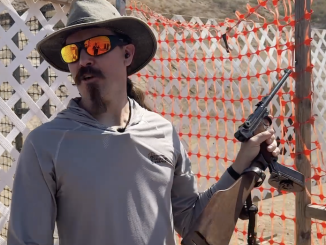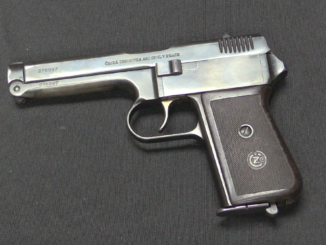Lot 524 in the September 2019 RIA auction.
Sweden tested the Luger in 1904, along with all the major semiauto pistols available at the time. The Luger was found to be the most accurate gun in the trials, but expensive and not as reliable in cold weather as the Browning 1903 – which was formally adopted as the m/1907 a few years later and produced under license at Husqvarna. Fast-forward to the 1930s, and Sweden has begun to purchase batches of submachine guns in 9x19mm. Their Browning pistols are in 9×20 Browning, and it would make a lot of sense to standardize on just one 9mm pistol cartridge. In 1938/9, Sweden held a second set of trials with the Luger (the New Model this time) the Walther HP (P38) and the Finnish Lahti M35.
The Lugers in question were 300 guns purchased form Mauser. They were all 1938 dated, with 275 in 9mm Luger with 4 3/4 inch barrels and 25 guns with 4 inch barrel chambered for .30 Luger. They did not receive and specifically Swedish markings, and can be identified only by serial number – 5700v to 6000v. Interestingly, the 9mm ones have salt-blued barrels but the other parts rust-blued (except for the small parts that were normally strawed).
The late 1930s testing once again found the Luger to be the most accurate pistol, but it was still expensive. A purchase of 1500 Walther HP pistols was made, but the outbreak of war interrupted the supply from Germany. Instead, the Lahti was adopted at the m/40 pistol, and produced in large numbers at Husqvarna as the Browning had been before it.




The Swedes must have been an optimistic bunch if they thought the Luger was going to have been cheaper in 1938 than it was in 1904.
According to http://www.gotavapen.se/gota/m40/pist40_1.htm
1926 the congress of Sweden believed that there would be no more war in the region and almost closed the budget for the defence forces. This reflected in very limited purchases of guns and especially of pistols. This trend remained until 1938! The standard army pistol at this was the pistol m/1907, manufactured by Husqvarna, which is similar to the Browning M1903 in 9 mm Browning long (9×20 mm semi rim). This rather weak cartridge (m/1907) was the standard cartridge in Sweden at that time for both pistols and submachine guns.
The cold winds of war came closer at 1939. It came like a shock, when the Soviet Union attacked our neighbour Finland in November 1939. All of a sudden the demand for more weapons became urgent in Sweden.
So I presume that they need weapons badly, so they rather judged it in terms of available vs not available rather than cheap vs expensive.
That Husquarna m/40 looks as simple and rugged handgun; I dare to say more suitable for military service in nordic country such as Sweden.
Btw. Husquarna company is alive and well producing new models of motorcycles (in cooperation with KTM of Austria).
Unless it is intentional show of disdain: Husqvarna
No it is not, it is typo.
I was amusied how, when their Lahtis wore out, they broke the old Brownings out of stores and reissued them, until they could search for a replacement. The Brownings were still serviceable — they just added the complexity of a unique cartridge to the logistics.
“(…)added the complexity(…)”
Introduction of new cartridge, namely m/39 was caused by urgent need for sub-machine guns, with storm rising above Europe, they did not have comfort to reject because “that sub-machine gun is not firing our cartridge”, according to http://www.gotavapen.se/gota/artiklar/kpist/swede_45.htm
1939 the war came closer and the demand for weapons were urgent in Sweden. The total number of m/37 submachine guns in the Swedish Army in 1939 was as low as 900!
Now Sweden bought 1800 submachine guns from Germany. This was the Bergman model 1935.
This submachine gun was unlike earlier Bergmann submachine guns not designed by Hugo Schmeisser. This is model 1935/1 and it was made with both long and short barrels. The prototypes for this gun were made in Denmark 1932. This invention became Bergmann M34/1 which after some modifications became M1935/1. It was made by the Walther Zella Mehlis plant for Sweden. Later during WW2 the same gun was made by Junker and Ruh. It was used by SS during WW2.
Together with this submachine gun 1500 Walther pistols model HP were bought. These weapons used the German cartridge m/08 equal to 9 mm Luger cartridge! This new cartridge was named m/39 in Sweden.
I would prefer the m/07 Browning any time over the Lahti as a weapon for self defence, because the m/07 can be carried much more conveniently.
In my opinion from shooting it and measuring real velocities, the 9 mm Browning long is by no means a “weak” cartridge.
I guess I can agree with you: Horses for courses, not courses for horses. A commissioned officer is not expected to decapitate enemy soldiers at 100 meters, because that task is a regular grunt’s job! And any hostile who manages to get killed by the officer’s side-arm in any random scuffle has forgotten that “not strong as a long rifle” does not equate to “weaker than a whack over the head with a brick.”
Don’t sell bricks short!
We just need a holster for concealed bricks!
Well put. We all know that pistol in officer’s holster was no more than enforcement of own side troops discipline, much less a threat to enemy soldiers.
“(…)In my opinion from shooting it and measuring real velocities, the 9 mm Browning long is by no means a “weak” cartridge.”
9 mm patron m/07 was – like later 9×18 Ultra and 9×18 Makarov – created as answer to question: what is most potent cartridge which could be reasonably used in blow-back operated automatic pistol. FN marketed automatic pistol firing that cartridge as Browning Modèle de Guerre so they did not have doubts it is fit for being service sidearm. However, what is enough for automatic pistol do not have to be enough for sub-machine gun, especially taking in account that in late 1930s/early 1940s, expectations about sub-machine gun were high.
Browning believed in 9mm cartridges (much more than in .45, that he designed only becuse he was requested to) and designed the .380 ACP as the ideal cartridge for blowback pocket pistols, the 9mm Browning Long as the ideal cartridge for blowback service pistols and the .38 ACP as the ideal cartridge for breechlock service pistols.
Like the 9X18mm Ultra, the 9mm Makarov and the 9mm Glisenti (power-wise they are all in the same ballpark), and before all those, the 9mm Browning Long was the most powerful round that could be used in a blowback pistol design without weight disadvantages.
Considered that a 9mm Glisenti (slightly the most powerful of the lot) has at the muzzle the same speed that a standard 9mm Luger has at 30m, that those service pistols shot exclusivey ball ammos, and that a 9mm luger ball projectile can pass completely trough a human body well beyond 100m distance, one has to wonder what the advantage of the adjunctive power of the 9mm Luger and of a complex breechlock design exactly was.
One great advantage the Lahti has over the Luger is that it is pretty much sealed against garbage getting into the action to cause stoppages. On the other hand, the Luger’s toggle action acted as a pump to feed dirt, ice, pine needles, whatever, into its interior.
Uh, really? Have you not seen the mud test results on the P08? If the Luger were so unreliable that it would jam from pine needles being near the breach, it would not survive past the autumn of 1914 in the trenches where worse obstructions existed. You should not imply that some random officer was stupid enough to stick his weapon into a pine tree branch like that!
Hey, forget pine needles – it is for own troops discipline…. and/ or a ball to one’s head. Another option is hands up which real officer avoids for almost any cost.